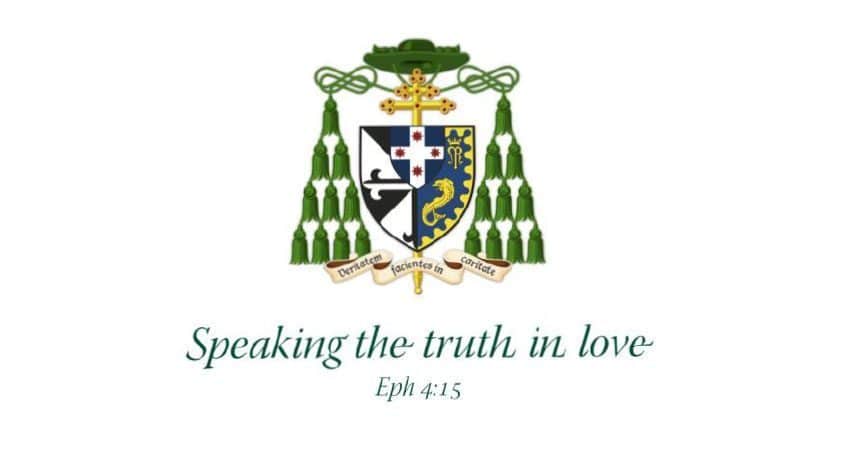HOMILY FOR MASS OF THE MEMORIAL OF ST. MARGARET OF SCOTLAND + INSTALLATION OF LECTORS

Redemptoris Mater Seminary, Villawood
At the end of Shakespeare’s great tragedy Macbeth, the king is dead and Malcolm is hailed King of Scots.[1] He undertakes to serve “by the grace of Grace” unlike the “dead butcher and his fiend-like queen”,[2] Lady Macbeth. But would his wife be any better?
Margaret was one of the last remaining members of the Anglo-Saxon royalty, banished from England by the Danish invaders in 1016.[3] Born in exile in Hungary (ca. 1045), Margaret and her family returned to England in 1057, only to witness another invasion and banishment a few years later, this time by the Normans (1066).[4] Now it was to the Scottish court they fled (1068). Malcolm III fell in love with the beautiful and pious Margaret and asked her to be his queen;[5] she hesitated because she had been considering a religious vocation, but finally wed in 1070. The marriage was a happy one, after the pattern of Paul’s hymn to love today (1Cor 12:31-13:13); of the eight children that followed three were King of Scots, one English queen and one a saint.[6] As our psalmist says: “Happy those who fear the Lord and take delight in his commands: their sons will be powerful on earth and their children Blessed.” (Ps 111)
The contrast between the Lady Margaret and Lady Macbeth could not have been more stark! Margaret brought an unusual grace to that rough country, and set about reforming her husband, who despite Shakespeare’s plaudits was no model of virtue. She opened his eyes to the moral life (especially quelling his temper), the intellectual life (beginning with reading and writing: she made a ‘lector’ of him) and the spiritual life (of prayer and sacrifice). Together they spent long hours kneeling side-by-side in prayer for their country.
The queen also promoted art and architecture, education and couture, and supported her husband in establishing a strong but civil court, feudal loyalty and the beginnings of a parliament. She sponsored efforts to suppress incest, usury and simony and engaged in charitable works such as ransoming captives and caring for orphans. The royal couple even waited upon the poor serving them food from the royal table—like Neocatechumenal seminarians waiting of each other. But as the food was Scottish it would not have been a patch on the Italian, Brazilians Colombian food customary here!
Margaret also sought to renew the Church, by promoting the Roman Rite in a nation still part Celtic-Christian, part-pagan, by campaigning to increase Mass attendance and Confession, and by importing English Benedictines to assist. She introduced the Black Rood, a relic of the True Cross, which was instantly Scotland’s greatest treasure.[7] When her husband and son died in battle in 1093, Margaret died of grief soon after—on this day—grasping and kissing the Rood as she departed. She was immediately revered as a saint, as would be her youngest son David. Her head was the principal relic in the keeping of Mary Queen of Scots until she lost her own. All in all, Margaret was a model of how the lay faithful can lead and serve in Church and society.
At the First Assembly of the Fifth Plenary Council of Australia it was recently alleged that the Church gives few opportunities to lay and married people, especially women, to lead. The point was well-made that there must be wide and better consultation of the laity. Many voices must be heard, co-responsibility recognised, gifts and expertise deployed. Pope Francis is also pressing us to conceive of the Church in more collaborative, synodal terms.
We are well down that road. Some weeks ago I made the point that lay women have always determined the future of the Church, above all by having children (or not) and by transmitting the faith to them (or not). For saying this I was accused of tone-deafness by James Carlton on ABC radio’s God Forbid programme,[8] because I had not mentioned fathers and had reduced women’s role to mothering. In fact I didn’t mention fathers because I was answering the charge that lay women have no role in Church leadership; and Mr Carlton knew I went on to detail many other ways women lead in the Church as well. But I also noted that Jesus’ approach to authority subverts secular understandings of power, and I stand by my claim that passing on the faith to a new generation is a crucial vocation and a good kind of spiritual power—one exercised by St Margaret.
If the parish church and school are the two principal meeting points for most people with the Church, then they usually encounter a male cleric as pastor of one and a lay woman as principal of the other. In this archdiocese, most departments and agencies are directed by lay women;[9] others are led by lay men.[10] There are lay women (and men) on our archdiocesan curia and seminary teams, as leaders or board members of parish councils and ministries, Catholic schools and universities, hospitals and aged care, social services and chaplaincies, religious institutes, PJPs and associations. Other lay people lead important ecclesial movements like the Way and ministries of their own. In recent years women have been national directors of Catholic education, healthcare, social services, and professional standards, echoing the lead formerly given by the nuns.
Granted, much of this is under-appreciated and insufficiently valorised. Granted, the progress is uneven around the country and even in Sydney. Granted, there is more to be done. Recently Pope Francis created a new lay ministry of catechist for both men and women and extended the lay ministries of acolyte and lector to women also. New opportunities for women’s leadership and service will continue to emerge. But Christian lay women after the example of St Margaret can make an enormous contribution to cultivating the virtues of family and community, to teaching the moral, intellectual and spiritual life, to care of the poor and making a more beautiful, compassionate and well-governed society. So, too, they renew the Church through prayer and devotion, by preaching the Word in those ears only they can reach, above all by the example of faithful and holy lives.
But what might a medieval queen and the musings of a bishop on women’s ministry have to do with seminarians about to be installed as lectors? Let me make a few concluding points.
First, St Margaret is a model not just of family life or Christian leadership in the world, but of doing God’s work wherever we find ourselves. She applied herself wholeheartedly as a missionary, with the Catholic faith as her lens and engine, in Hungary, England then Scotland, despite difficulties of language and differences of culture, and her efforts bore great fruit. Margaret would have been mystified by post-modern disputes about women’s power and preaching, or about lay experts displacing clerics in governance of the Church. She had no trouble finding her own arenas to preach and influence. Of course, not everyone has opportunities like she had. But by transforming secular power into Christian authority, authority into service, and service into the total gift of the self, Margaret gave an example to priestlings as much as to lay people and civic leaders.
Secondly, in today’s Church, bishops and priests are called to exercise co-responsibility with all the baptised in their offices of governance, preaching and sanctification. Your participation in Neocatechumenal communities should help you prepare for a life of team ministry with lay people even as you exercise the role proper to presbyters and to avoid any unhealthy clericalism even as you maintain a proper clerical identity.
Today my dear sons, Alejandro, Wellington and Nonie, you will be installed in the Ministry of Lector. Through His Son who is the Word of God, spoken from all eternity by the Father and spoken in time as Jesus Christ, God has revealed the mystery of salvation and brought it to fulfilment. To us He has entrusted the mission of proclaiming that Word to all the world.
As instituted lectors you share with others appointed to read the Word of God in the assembly the great responsibility of preparing and pondering that Word before you read it. But as holders of this office along the journey to priesthood, you have a particular service of the faith and love to give, one that must always be rooted in the Word of God and the desire to be a shepherd. For you being a candidate, lector or acolyte mark stages along the adventure of proclaiming the Gospel and of the mystery of your vocation. For “You did not choose me,” Jesus reminds us today, “no I chose you, and commissioned you to go out and bear fruit, fruit that will last!” (Jn 15:9-17)
INTRODUCTION TO MASS OF THE MEMORIAL OF ST. MARGARET OF SCOTLAND + INSTALLATION OF LECTORS
Redemptoris Mater Seminary, Villawood
A warm welcome to all of you to this Mass for the Memorial of St. Margaret of Scotland, a saint to whom I expect many of you already have a great personal devotion… I’m very glad that we have returned to a sufficient degree of normalcy to allow both this year’s visitation of the seminary and the Rite of Installation of Lectors for Alejandro Giraldo Alvarez, Wellington de Oliveira Prando and Nonie Calunsod Tiburan in the presence of more than just the seminary insiders.
[1] In fact it was Malcolm who killed Macbeth on 15 August 1057 at Lumphanan in Aberdeenshire, not Macduff at Dunfermline as Shakespeare had it. Macbeth was succeeded not by Malcolm (as Shakespeare has it) but by Macbeth’s stepson Lulach, who was crowned at Scone on 8 Steptember 1057. Lulach was also killed by Malcolm, near Huntly on 23 April 1058. Only after this was Malcolm inaugurated as king, on 25 April 1058.
[2] Shakespeare, Macbeth, Act 5, Scene 7.
[3] Margaret was born in the Kingdom of Hungary to Edward Ætheling (or Edward the Exile) who spent most of his life in banishment following the defeat of his father Edward Ironside of Wessex by the Danish King Canute in 1016.
[4] Following the death of King Harold at the Battle of Hastings, Margaret’s brother Edgar Ætheling was elected king but never crowned, as the Norman king, William the Conqueror, soon assumed control.
[5] There is some dispute about whether Malcolm was previously married to a Dane, Ingibjǫrg Finnsdóttir.
[6] Edgar (King of Scots 1097-1107), Alexander I (King of Scots 1107-24) and St David I (King of Scots 1124-53); if Edmund of Scotland (who ruled with his uncle Donald III 1093-94) is counted, she was mother of four kings. Princess Edith, renamed Matilda or Good Queen Maud, was Queen consort of England to Henry I 1100-18 and Regent of England in 1104, 1107, 1108 and 1111.
[7] She installed the Rood in Dunfermline where she had been married, had established an abbey, and would be buried. Her son, David I, would later move the relic to his capital in Edinburgh and build Holyrood castle and monastery around it after “a night of a tussle with a muckle hart”.
[8] https://www.abc.net.au/radionational/programs/godforbid/the-catholic-plenary-%E2%80%93-where-to-from-here/13588716.
[9] e.g. the Directors of Aboriginal Catholic Ministry, Archives, Caritas Sydney, the Catholic Institute of Sydney, the Child Protection and Safeguarding Office, the Vicar for Consecrated Life, Sydney Catholic Early Childhood Services, the Ecumenism and Interfaith Office, the Ephpheta Centre for the Deaf, the Legal Department, the Parish Renewal Team, and our directorate for Public Affairs & Engagement.
[10] e.g. the Chancellor and the Executive Director Administration & Finance, the directors of the Anti-Slavery Taskforce, CatholicCare, the Catholic Development Fund, the Catholic Weekly, Fundraising, Confraternity of Christian Doctrine, the Life, Marriage and Family Office, Sydney Catholic Schools, Sydney Catholic Youth, the Sydney Centre for Evangelisation, and University Chaplaincies.

